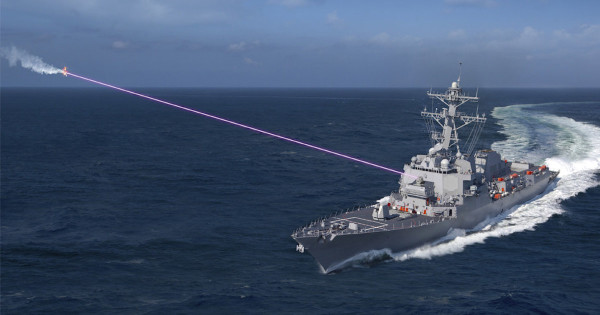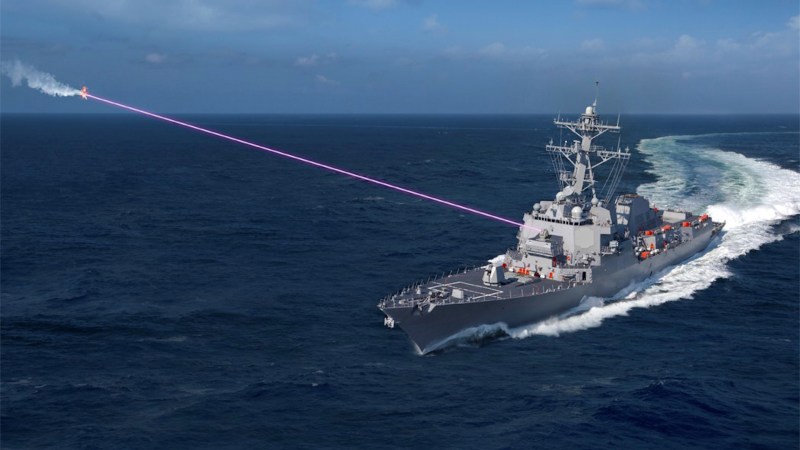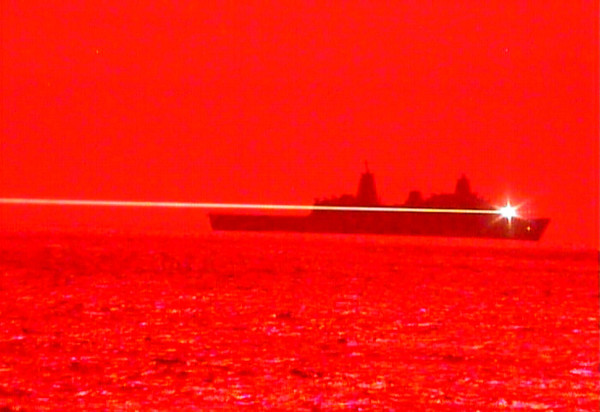The Navy has now taken possession of a half-dozen new laser weapons for integration onto surface warships, officials said on Wednesday.
Speaking at the Surface Navy Association’s annual conference in Virginia about the Navy’s future DDG(X) surface combatant vessel, Rear Adm. Seiko Okano, program executive officer for integrated warfare systems, revealed that the service has now received one High Energy Laser with Integrated Optical-dazzler and Surveillance (HELIOS) weapon system from defense contractor Lockheed Martin, and seven Optical Dazzling Interdictor, Navy (ODIN) systems from Government developers at the Naval Surface Warfare Center in Dahlgren, VA.
Those systems “are now being integrated onto ships,” as National Defense magazine reported from the SNA conference.
Developed under a 2018 contract with Lockheed, the HELIOS consists of a 60-kilowatt laser and optical dazzler package designed to knock out unmanned aerial vehicles, “burn the boats,” and disrupt both airborne and shipborne intelligence, surveillance, and reconnaissance sensors, according to the Congressional Research Service.
The lower-power ODIN laser dazzler provides “near term” capabilities to disorient and neutralize aerial drones and knock out a variety of intelligence, surveillance, and reconnaissance assets, per CRS.
As swarms of drone aircraft, watercraft, and anti-ship missiles pose growing threats to surface vessels, laser weapons systems will prove an ideal low-cost, near-unlimited ammo countermeasure to deter potential attacks.
Subscribe to Task & Purpose Today. Get the latest military news, entertainment, and gear in your inbox daily.
Speaking at the same SNA panel as Okano, Rear Adm. Fred Pyle, the Navy’s director of surface warfare, stated that the service is “going to continue to invest with directed energy to get to those higher levels so we can move beyond self-defense and get into more warfighting missions.”
“Move beyond self-defense” likely means upping the HELIOS from its current 60-kW output to something more in the range of 120 or 150 kW.
News of the Navy’s laser surge may come as a surprise to some observers given that the service accepted delivery of its first HELIOS system just two years ago and showed up installed on the Arleigh Burke-class destroyer USS Preble as recently as August 2022.
But as Janes noted in April, the service’s fiscal year 2023 budget proposal designated its wide-ranging Navy Laser Family of Systems, which the HELIOS falls under, as “an accelerated acquisition initiative to provide near-term, ship-based laser weapon capabilities,” highlighting a push to field laser weapons to surface warships as soon as possible.
Despite this push, it’s unlikely the fleet will see the rapid fielding of lasers this fiscal year: the Navy’s budget request called primarily for further at-sea testing of the HELIOS following the successful integration of the weapon system aboard the Preble last year.
Officials previously stated that the DDG-51’s Flight III design is summarily flawed in that it focuses most of its electrical power generation on the AN/SPY-6 Air and Missile Defense Radar (AMDR), making the service’s fleet of Flight IIA destroyers the choice platform for laser integration.
“[W]e are out of Schlitz with regard to power,” as then-Navy director of surface warfare Rear Adm. Ron Boxall put it back in 2019 in reference to the AMDR to the Flight III hulls. “’We used a lot of power for that and we don’t have as much extra for additional functions.”
While the Navy may struggle with long-term integration into those newer Flight III destroyers due to power generation, service officials hope the new DDG(X) surface combatant discussed at the SNA conference will manage to solve the power generation problem.
Indeed, previously-released prospective configurations for the next-generation destroyer — intended to replace both the Arleigh Burke and Ticonderoga classes starting in fiscal year 2030 — to rock dual 600-kW lasers on its stern for missile defense and a single 150-kW laser for small UAVs and watercraft on its bow.
“Shipbuilding is a long game, right?” Pyle said, per National Defense magazine. “So when we achieve the directed energy power that we’re looking for, or high power microwaves — or whatever that may be — or lasers, we want to have a platform to land it on.”
CORRECTION: 1/23/23: This article originally stated that the Navy had received six High Energy Laser with Integrated Optical-dazzler and Surveillance (HELIOS) weapon systems based on public comments from Rear Adm. Seiko Okano. Following this article’s publication, the Navy’s Chief of Information office clarified that the service has received just one HELIOS weapon system, as well as seven Optical Dazzling Interdictor, Navy (ODIN) systems.
The latest on Task & Purpose
- Army general investigated for defending female troops online retires honorably
- Marine Corps boots poolee tied to neo-Nazi groups
- Soldier assigned to 7th Special Forces Group charged with killing wife
- This unusual new Air Force tactic is likely raising alarms in China, expert says
- Here’s how Ukraine could use the Bradley Fighting Vehicles it’s getting from the US, experts say
Want to write for Task & Purpose? Click here.

















